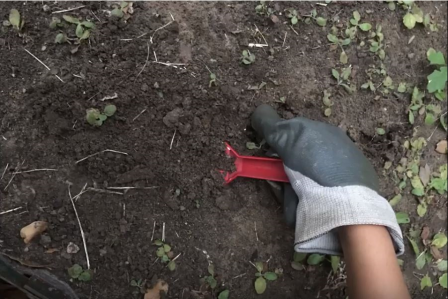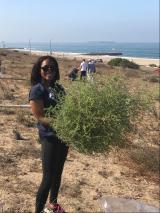President's Environmental Youth Award
Your project--or one you are sponsoring--could be an award winner. Apply or encourage a student you know to apply for PEYA and see what a difference they can make for the environment with an award-winning project. Applicants from all 50 states as well as U.S. territories are eligible to compete for a regional certificate of special recognition and a national Presidential award.
The 2020-2021 PEYA competition is now open! Please see below for how to apply.
- History and basic information
- How the program works
- How to apply
- Judging criteria
- Recognition of winners
- Sponsors
- Questions
History and Basic Information about the President's Environmental Youth Award
The President’s Environmental Youth Award (PEYA) recognizes outstanding environmental projects by K-12 youth. The PEYA program promotes awareness of our nation's natural resources and encourages positive community involvement. Since 1971, the President of the United States has joined with EPA to recognize young people for protecting our nation's air, water, land, and ecology. It is one of the most important ways EPA and the Administration demonstrate commitment to environmental stewardship efforts created and conducted by our nation's youth.

- restoring native habitats
- recycling in schools and communities
- construction of nature preserves
- tree planting
- installing renewable energy projects
- creating videos, skits and newsletters that focused on environmental issues
- participating in many other creative sustainability efforts
Evaluation results consistently demonstrate that participation in the PEYA program is frequently a life-changing experience for many of the young people and their project sponsors.
How the Program Works
PEYA has two parts — a regional award for Grades K-5 and a regional award for Grades 6-12.
EPA has ten regional offices across the country. Based on the evaluation criteria, each regional office will be responsible for selecting up to two winners per region– one for Grades K-5 and one for Grades 6-12. Applicants are welcome to include youth across multiple grade levels; however, the application will be categorized based on the applicant with the highest grade level. For example, if one applicant group consists of two 4th graders, one 3rd grader and one 6th grader, the application will be evaluated in the Grade 6-12 category.
Each award-winning project will receive a Presidential plaque. All qualified applicants will receive recognition from EPA leadership honoring them for their efforts to protect human health and the environment.
Eligibility
- Project is completed while the applicant(s) is in kindergarten through 12th grade.
- Applicant(s) is a citizen of the United States or its territories or has been lawfully admitted for permanent residency.
- Represented by a teacher sponsor. If the sponsor is not a teacher, the sponsor must seek a co-sponsor that is a teacher. For home-schooled applicants, teacher sponsor can be a parent.
- The sponsor/co-sponsor must be an adult at least 21 years of age.
- Projects started on or after January 1, 2020, are eligible for consideration. As long as there was activity on the project after January 1, 2020, a project initiated prior to that date is eligible for consideration.
-
Project must include an environmental stewardship component.
How to Apply for the National Award Program
Step 1: Review the Eligibility Criteria
- Project is completed while the applicant(s) is in kindergarten through 12th grade.
- Applicant(s) is a citizen of the United States or its territories or has been lawfully admitted for permanent residency.
- Represented by a teacher sponsor. If the sponsor is not a teacher, the sponsor must seek a co-sponsor that is a teacher. For home-schooled applicants, teacher sponsor can be a parent.
- The sponsor/co-sponsor must be an adult at least 21 years of age.
- Projects started on or after January 1, 2020, are eligible for consideration. As long as there was activity on the project after January 1, 2020, a project initiated prior to that date is eligible for consideration.
- Project must include an environmental stewardship component.
Step 2: Complete an Application
- Download the application.
- A project summary of up to 300 words must be provided on the application form. Please note that applicants that are applying in the 6-12 grade level category must complete the project summary section themselves. Applicants in the K-5 grade level may be advised by the sponsor and sponsors may assist in the writing of the project summary.
- A more detailed description of the project, no more than five pages, and addressing each of the evaluation criterion should be attached to the application.
- Applicants may submit up to five additional pages of photographs, newspaper articles, and other supporting materials to provide a more comprehensive view of the project. Accompanying videos must be web-based with functioning links (e.g., no CDs).
- Sponsors must sign and date page A-3 of the application.
Step 3: Submit the Application
- For this year’s competition, applicants are strongly encouraged to submit all application materials electronically (email). If you plan to mail some or all of your application materials, please contact us at peya@epa.gov so that we can ensure receipt.
- All teachers and sponsors/co-sponsors will receive a confirmation email upon receipt of the application package.
- Email completed application materials to peya@epa.gov by 11:59 p.m. ET on February 19, 2021. Applicants are encouraged to combine complete set of application materials into a single email.
- Mailed applications must be received by February 19, 2021, at the address below to be eligible for consideration:
U.S. Environmental Protection Agency
Office of Environmental Education
Attn: President's Environmental Youth Award Program
William Jefferson Clinton North, Room 1426
1200 Pennsylvania Ave, NW, MC 1704-A
Washington, DC 20460
Judging Criteria
Each application is evaluated by a regional awards panel. The panel members review and evaluate each application based on the criteria. There are separate evaluation criteria for K-5 and 6-12 applications. A maximum of 100 points can be awarded to a given application.
| Evaluation Criteria | Points |
|---|---|
|
Youth Initiative: How did the applicant(s) come up with the idea for the project? To what extent does the applicant(s) take charge of the project? |
15 points |
|
Environmental Stewardship* and Impact: Was there an environmental stewardship component to the project? How did the applicant(s) identify the environmental need for this project? How did the project positively affect the environment? Did the student(s) complete the project? |
30 points |
|
Achieving Project Goals: Winning projects may highlight environmental stewardship in a variety of areas, including:
How did the project address one of the focus areas of the competition, including:
|
15 points |
|
Community Involvement: To what extent did the project involve others in the school or community? Please describe the community. |
15 points |
|
Project Creativity and/or Innovation: What creative and/or innovative approach(es) did the applicant(s) use for the project? |
15 points |
|
Project Approach: To what extent does the application tell a complete story about the project? Did the applicant(s) have a thought-out approach to solving the problem? |
10 points |
| Total | 100 points |
| Evaluation Criteria | Points |
|---|---|
|
Youth Initiative: To what extent was the project designed, coordinated and implemented due to applicant (s) initiative? How was the project created and completed by the applicant(s)? The driving force for the project must be the applicant(s), not the sponsor. |
15 points |
|
Environmental Need and Appropriateness: To what extent was there a clear environmental need for the project? How appropriate was the project for the community in which it was performed? |
20 points |
|
Environmental Stewardship* and Impact: Was there an environmental stewardship component to the project? How did the project positively affect the community? Were there any long-term environmental benefits or outcomes of the project? Did the student(s) complete the project? |
15 points |
|
Achieving Project Goals: Winning projects may highlight environmental stewardship in a variety of areas, including:
How did the project address one of the focus areas of the competition, including:
|
15 points |
|
Community Involvement: To what extent did the project positively involve others in the community? Please describe the community What community resources, expertise, leadership, or publicity did the applicant(s) use? |
15 points |
|
Project Creativity and Innovation: How did the applicant(s) use creative and/or innovative approaches to achieve positive results? |
10 points |
|
Soundness of Approach, Rationale, and Scientific Design: Was the approach to the problem clear? Did the applicant(s) have a sound justification for choosing that approach? If so, what is that justification? |
10 points |
| Total | 100 points |
- living or conducting business in such a way as to minimize or eliminate pollution at its source;
- using natural resources efficiently;
- decreasing the use of hazardous chemicals;
- recycling wastes effectively; and
- conserving or restoring soil, forests, prairies, wetlands, rivers, and parks.
Stewardship can be practiced by individuals, groups, schools, organizations, companies, communities, and state and local governments.
Recognition of Winners
Each year, EPA gives a Presidential plaque to the national award winners, and EPA leadership recognizes all qualified applicants in a letter or certificate.
Read about current and past PEYA winners.
Sponsors
Each applicant or group of applicants applying for PEYA must be represented by a teacher sponsor. For home-schooled applicants, the teacher sponsor can be a parent. The teacher sponsor must certify that the project was been completed by all applicants.
Typically, a sponsor offers suggestions and advice throughout the project to:
- develop a well-thought-out project;
- implement the project;
- work with other groups and individuals in the community;
- complete the application form (for K-5 applicants); and
- assist in preparing accompanying materials.
The sponsor/co-sponsor must also sign and date the application.
Questions about the role of a sponsor should be directed to peya@epa.gov.
Resources for Sponsors
Questions
Questions about the program should be sent to peya@epa.gov.

